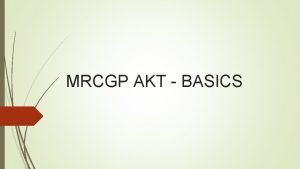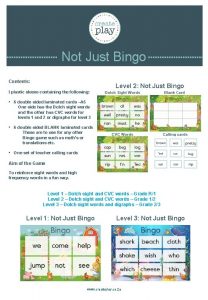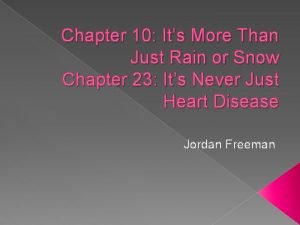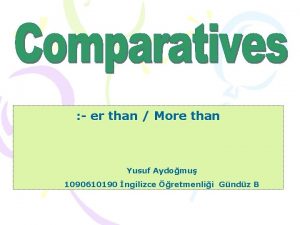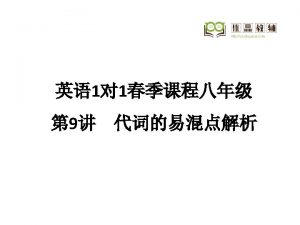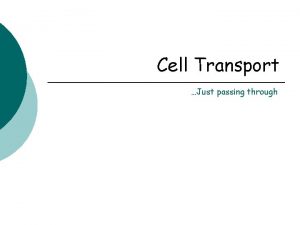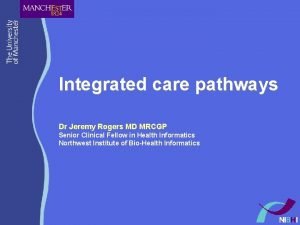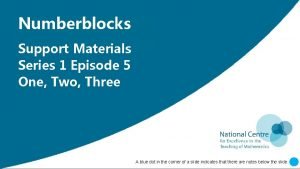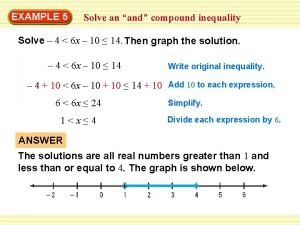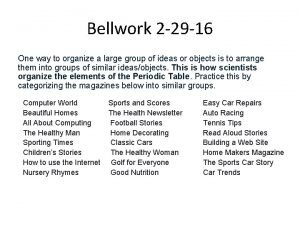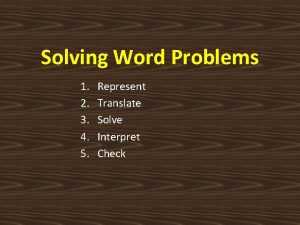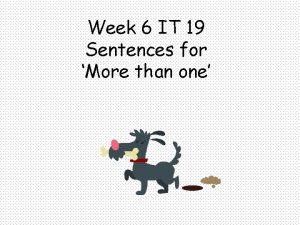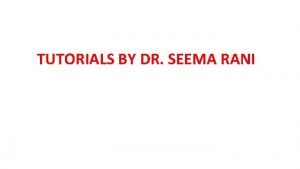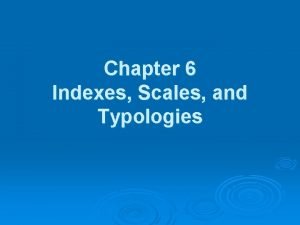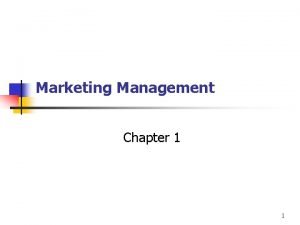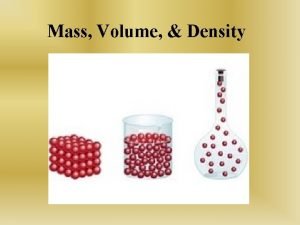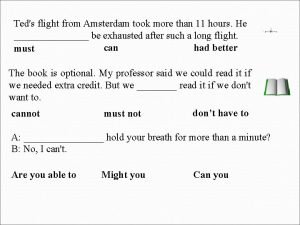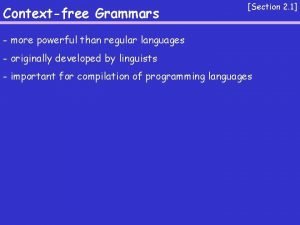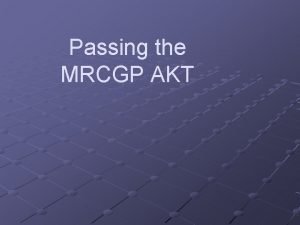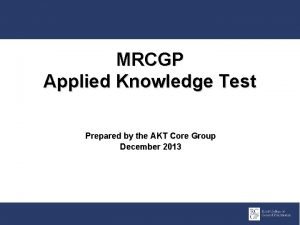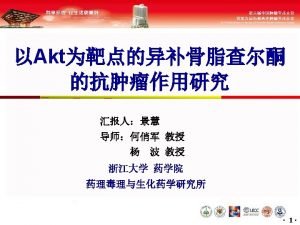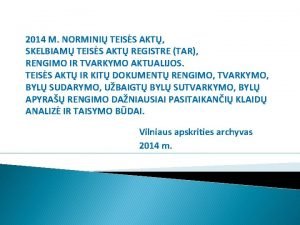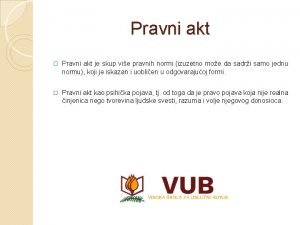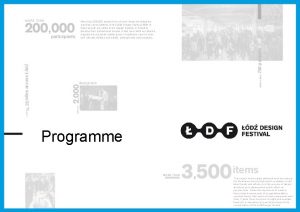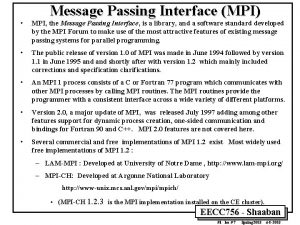Passing the MRCGP AKT More than just revision









































- Slides: 41

Passing the MRCGP AKT More than just revision? Helping GPSt. Rs prepare better Iain Lawther

For discussion What do trainers actually know about the examination? What do we normally do to help GPSt. Rs prepare for the AKT? Do we know what works and what doesn’t? Does the GPSt. R’s demographic status matter? How should we respond when GPSt. Rs fail?

The AKT Forms an essential part of the MRCGP n “A summative assessment of the knowledge base that underpins independent general practice in the United Kingdom” Computer-based test of 200 questions Extended to three hours and ten minutes in October 2014 Offered 3 times annually n 150 Pearson VUE professional testing centres across the UK

RCGP question reference sources GP Curriculum - latest version Content Guide for the AKT BNF GMC Good Medical Practice RCGP Essential Knowledge Updates NICE guidelines

RCGP question reference sources SIGN guidelines BMJ Review articles & original papers BJGP Cochrane Vaccine update newsletter (www. gov. uk)

Examination composition 80% Clinical medicine 10% Critical appraisal 10% Health informatics and administrative issues All questions aim to test higher order problem solving, not just simple factual recall

Principles for question construction Relevance n The AKT should be relevant to mainstream general practice High prevalence n Any topic covered can be one which occurs commonly High impact n One which is significant but perhaps less common

General principles for success Time management is vital n A clock is shown on the test screen Watch the countdown carefully n There is an average of 57 seconds per question Some questions can be answered far quicker than others n n n If the answer isn’t obvious immediately, flag it and move on Reserve time to return to unanswered questions at the end A calculator has also been added for questions where arithmetic might be needed

General principles for success Read the questions carefully n Marks are lost easily by skim reading, misinterpreting the question or failing to extract the key features in a clinical scenario IMGs who read more slowly might want to flag long or verbose questions and return to them later n These take up more time per question and impact negatively on mark acquisition

General principles for success In general, it is better for candidates (particularly IMGs) to concentrate on the clinical medicine questions n Taking all factors into account, these offer the highest return in terms of actual marks Go through unanswered questions a second time using the review screen n There is no negative marking, so do not leave any questions unanswered Try and check for obvious errors if there is still time n Misreading or misinterpreting questions is not uncommon under stress

Question formats (1) Single best answer (SBA) n n n One answer is correct and is based on national (not local) guidance or best practice Other options might be plausible, but are inserted as “distractors” If the question is a clinical case scenario, pattern recognition will apply

SBA example A 50 -year-old man has become increasingly tired and lethargic over the past six months and has developed erectile dysfunction. His wife comments that he looks tanned even in the winter months. His serum ferritin and transferrin levels are significantly raised, but his haemoglobin is normal. Which is the SINGLE MOST likely diagnosis? Select ONE option only. n n n A Addison’s disease B Chronic active hepatitis C Diabetes mellitus D Haemochromatosis E Hypothyroidism

SBA working • A 50 -year-old man has become increasingly tired and lethargic over the past six months and has developed erectile dysfunction. His wife comments that he looks tanned even in the winter months. His serum ferritin and transferrin levels are significantly raised, but his haemoglobin is normal. • In this case, the skin changes could be consistent with Addison’s disease and the lethargy could be a very relevant symptom in hypothyroidism or diabetes mellitus. However, only haemochromatosis would be consistent with all of the features presented • Getting GPSt. Rs to practice keyword information extraction is a powerful way of approaching these questions

Question formats (2) Multiple Best Answer (MBA) n n n The candidate is asked to pick more than one correct answer Any number of answers might apply Usually these answers are deemed more likely to apply than the others

MBA example Specialist referral is MOST APPROPRIATE for which TWO of the following children? Select TWO options only. n n n A A four-week-old boy whose mother reports he does not smile B A four-month-old girl who cannot grasp an object when it is placed in her hand C A four-month-old boy who cannot sit unsupported D A two-year-old girl who cannot hop E A three-year-old boy who cannot combine words into a simple sentence

MBA working In this question, answers B and E are correct n n n Here, clinical knowledge is required, but a systematic approach to eliminating much less likely answers will identify correct answers from distracting ones Not smiling at 4 weeks of age, being unable to sit unsupported at 4 months and being unable to hop at an age of 2 years would not raise concerns Answers A, C and D are therefore much less likely

Question formats (3) Extended Matching Questions (EMQ) n n n These questions contain a list of possible options Most commonly, there will be two or more scenarios and the candidate is asked to choose the MOST appropriate option that BEST matches each given scenario Each option might be used once, more than once, or not at all

EMQ example A. Cerebral artery aneurysm B. Cerebral glioma C. Drug-induced D. Graves’ disease E. Ischaemic stroke F. Multiple sclerosis G. Myasthenia gravis For the patient described, select the SINGLE MOST likely diagnosis from the list of options:

EMQ example A. Cerebral artery aneurysm B. Cerebral glioma C. Drug-induced D. Graves’ disease E. Ischaemic stroke F. Multiple sclerosis G. Myasthenia gravis For the patient described, select the SINGLE MOST likely diagnosis from the list of options: 1. A 35 -year-old man who is a non-smoker, suddenly develops a severe headache and double vision. His right pupil is fixed and dilated.

EMQ example A. Cerebral artery aneurysm B. Cerebral glioma C. Drug-induced D. Graves’ disease E. Ischaemic stroke F. Multiple sclerosis G. Myasthenia gravis For the patient described, select the SINGLE MOST likely diagnosis from the list of options: 2. A 48 -year-old woman has transitory double vision towards the end of most days. She smokes 10 cigarettes per day. She has vitiligo and hypothyroidism.

EMQ working In this question, answers A and G are correct n n In the first case, subarachnoid haemorrhage from a ruptured cerebral artery aneurysm is the most likely cause In the second case, the autoimmune, social and medical history information suggests myasthenia gravis as the most likely cause As with SBA questions, practice with pattern recognition is vital in preparing for these questions

Question formats (4) Table or algorithm completion n These questions require candidates to pick several options from a list These are used to complete an algorithm on the screen or fill in blanks in a process The structure of the question will dictate whether the order of answers is important or not

Table or algorithm example MATCH EACH drug to the MOST LIKELY side effect n n A. Diclofenac B. Hydroxychloroquine C. Infliximab D. Methotrexate Side effect Bone marrow suppression CVA Retinopathy Septicaemia Most likely causative drug

Table or algorithm working Side effect Most likely causative drug Bone marrow suppression Methotrexate CVA Diclofenac Retinopathy Hydroxychloroquine Septicaemia Infliximab All four listed side-effects have to be placed correctly to gain one mark

Question formats (5) Picture format n n n A picture is given which represents a common condition A brief clinical summary is presented and the candidate is asked to pick the most likely answer The picture will try to present a highly typical appearance The picture will be in colour and of high resolution Dermatology cases are by far the commonest

Picture format example Skin infections in children n An eight-year-old child has had a localised rash around the nose for two days.

Picture format example Which is the SINGLE MOST appropriate MINIMUM number of days that this child should be kept away from school once treatment has started? Select ONE option only n n n A 1 B 2 C 3 D 5 E 7

Picture format working Answer: B (2 days) Once treatment starts, the earliest a child can return to school is after 2 days, provided there is a good response to treatment Practical knowledge of incubation and quarantine periods will be required and is frequently asked by parents

Question formats (6) Drag and drop n n These questions follow much the same format as Table or Algorithm completion In contrast, rely on simple drag and drop answers to complete the fields

Question formats (7) Data interpretation n n Typically, these questions relate to groups of patients with chronic conditions The understanding of common statistical terms will be tested Information is normally presented as a graph, data plot or bar chart Some variation might occur where clinical data is presented as laboratory results relating to a particular clinical case

Data interpretation example The following graph shows age-standardised INCIDENCE rates for common cancers in males in the United Kingdom (2008 -2010)

Data interpretation example Which SINGLE cancer is represented by the bar labelled 1? Select ONE option only n n n A Bladder B Colorectal C Lung D Non-Hodgkin’s lymphoma E Prostate

Data interpretation working Answer: E (Prostate) n n n It is important to know about the epidemiology of common cancers This includes an understanding of terms such as incidence, prevalence and mortality rates Research and statistics questions are designed to test an understanding of data and different ways it might be presented and interpreted

Data interpretation working n n In terms of preparation, the Trainer should encourage the candidate to become familiar with common data formats The best preparation can be done with data presentation on journal articles. Examples might include looking at tables and statistical conclusions, forest and funnel plots and other visual information.

Data interpretation working n A revision of common statistical terms is vital Examples might include sensitivity, median and mean, numbers needed to treat and others n n n Overall, most candidates score fewer marks in these areas Although this domain accounts for only about 10% of questions, a strong performance can boost overall scoring disproportionately This can be of great value to IMGs The question format is more visual and diagrammatic, reducing the impact of inherent linguistic factors

Question formats (8) Free text n n These questions require a text answer to be added From a marking perspective, they avoid the simple random guess approach, but the marking can become slightly less objective IMGs might find these questions more challenging and also time consuming Consider these factors when tackling such questions early in the examination Using a flag, move on and return later strategy is helpful

Question formats (9) Rank ordering n n Questions such as these will ask candidates to rank a number of options in ascending or descending order There might be a list of potential orders to select from, or the candidate might be required to list their suggested order in free text

Rank ordering example The list below contains four commonly prescribed topical steroid preparations n n 1 Clobetasol propionate 0. 05% 2 Clobetasone butyrate 0. 05% 3 Hydrocortisone 0. 5% 4 Hydrocortisone butyrate 0. 1%

Rank ordering example Which of the following represents the order of preparations from LEAST to MOST potent steroid? Select ONE option only n n n A 3, 2, 4, 1 B 3, 4, 1, 2 C 3, 4, 2, 1 D 4, 2, 3, 1 E 4, 3, 1, 2 F 4, 3, 2, 1

Rank ordering working In this case, answer A is correct (3, 2, 4, 1) n n 3 Hydrocortisone 0. 5% 2 Clobetasone butyrate 0. 05% 4 Hydrocortisone butyrate 0. 1% 1 Clobetasol propionate 0. 05% Hydrocortisone is a mild topical steroid, Clobetasone butyrate (Eumovate) is moderate strength, Hydrocortisone butyrate (Locoid) is potent and Clobetasol propionate (Dermovate) is very potent

Thank you! Any questions?
 More more more i want more more more more we praise you
More more more i want more more more more we praise you More more more i want more more more more we praise you
More more more i want more more more more we praise you Akt question bank
Akt question bank Akt exam review
Akt exam review Notjustbingo
Notjustbingo Math is more than just numbers
Math is more than just numbers It's more than just rain or snow
It's more than just rain or snow Software is more than just
Software is more than just Thousands of possibilities get yours slogan
Thousands of possibilities get yours slogan Generous kelimesinin comparative hali
Generous kelimesinin comparative hali 5730x5
5730x5 It is greater than god and more evil
It is greater than god and more evil Just passing through cell membrane
Just passing through cell membrane Revision passive voice
Revision passive voice Mrcgp pathway
Mrcgp pathway How many scenes are in act 5 of romeo and juliet
How many scenes are in act 5 of romeo and juliet A grosso has a group of soloists rather
A grosso has a group of soloists rather Percents less than 1
Percents less than 1 Jesus lord of heaven
Jesus lord of heaven Fractions greater less than or equal to
Fractions greater less than or equal to Numberblocks
Numberblocks Key words for less than
Key words for less than Greater than less than examples
Greater than less than examples Which fraction is the odd one out
Which fraction is the odd one out Element name
Element name Henry like pizza more than brainly
Henry like pizza more than brainly Why does new guinea have more species of birds than bali?
Why does new guinea have more species of birds than bali? One angle is 22 less than thrice the other
One angle is 22 less than thrice the other Turing machine is more powerful than: *
Turing machine is more powerful than: * Hydrolysis of furan
Hydrolysis of furan Now cook more than intelbased models
Now cook more than intelbased models Sentence climb
Sentence climb Marketing more than any other business function deals with
Marketing more than any other business function deals with What did anne think of the stiff backed notebook
What did anne think of the stiff backed notebook Indexes scales and typologies
Indexes scales and typologies Can an atom have more neutrons than protons
Can an atom have more neutrons than protons Marketing more than any other business function deals with
Marketing more than any other business function deals with Mass volume density video
Mass volume density video Ted's flight from amsterdam
Ted's flight from amsterdam Cfgs are more powerful than
Cfgs are more powerful than Closed or open circle for inequalities
Closed or open circle for inequalities Why do some earthquakes cause more damage than others
Why do some earthquakes cause more damage than others



